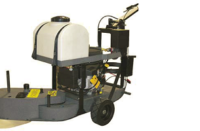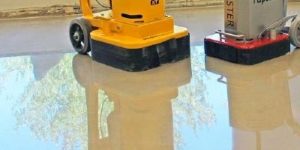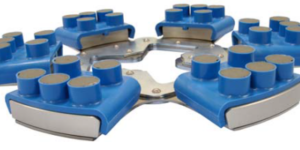I recently had a good conversation with a contractor about a project that seemed to start out well but ended up having two separate issues. This 60,000-square-foot project was to receive a high-gloss polished concrete finish. The concrete was placed after the building structure, including the exterior walls and the roof, were in place. The concrete placement contractor had done a great job on the finishing of the concrete and applied a dissipating curing compound to the surface per specifications.
Then the problems started.
A dissipating cure is exactly the right compound to use on a polished concrete floor. Generally, these types of curing compounds break down from traffic and exposure to sunlight and are mostly gone within a few weeks. The issue with this particular project was that the placement contractor sprayed the curing compound on heavily to ensure 100 percent coverage. This extra thickness, coupled with the fact that the building was in shade because the roof was already on, meant that the dissipating cure compound did not dissipate.
When the grinding contractor started working, the curing compound built up on the diamond segments under the grinders. This caused heavy scratching and, depending on the tooling used, either reduced the diamonds’ ability to cut or caused additional heat buildup, which made the diamonds wear away extremely quickly. The contractor tried six different diamonds from multiple manufacturers.
There are two ways to address the issue of the remaining cure compound. Either the contractor can chemically strip the floor and remove the remaining material, or the contractor can grind wet, allowing the diamonds to remain cool and continue cutting. Grinding wet also allows the diamond selected to cut deeper, helping to remove the compound.
How to avoid scratch rows when wet-grinding
The owner of this contracting company opted for the chemical removal route because, as he said, his crews always had bad scratch rows when grinding wet. The fix for this is surprisingly simple.
Adding water allows diamonds to cut deeper. Generally, this depth should be considered to be one step below the actual diamond selected. For example, if a 40-grit diamond is used dry, it cuts like a 40. If a 40-grit diamond is used wet, it will cut like a 25.
What I discovered after talking through the issue is that this contractor would run a 40-grit wet and then use an 80-grit dry to remove the 40 scratches. That wasn’t right. If the 40 cuts like a 25-grit wet, you would need a 40-grit dry in order to remove the scratches. When the floor was recut with the proper grit, the scratches were easily removed.
There are occasions when the density of the concrete, the tightness of the surface paste, the presence of a sealer or curing compound, or several other issues may dictate that the first grind or two of a polished concrete floor need to be completed using water. This is a normal part of the polishing process and should not be shied away from.
Additionally, if the building is covered, the curing compound may not be necessary at all. Water may be used in its place.
If a curing compound is used, the application rate needs to be closely reviewed and the polishing contractor should consider all of these situations when working up the bid for the project.
















